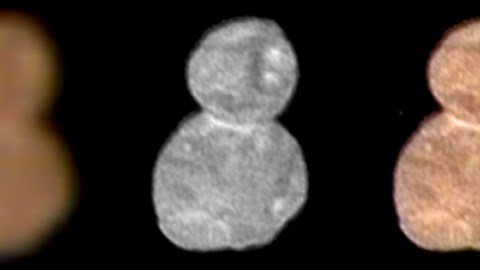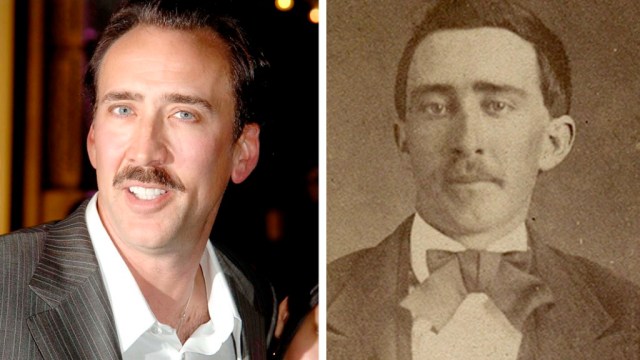What we can learn from Ultima Thule

What a way to celebrate the New Year!
While lots of folks were drinking, watching the ball drop, or singing “Auld Lang Syne,” the astronomically oriented among us were gleeful casting our imaginations out to the edge of the solar system. Out there, where the Sun barely appears as more than just another star, the New Horizons space probe was making contact with the most distant object we’ve ever visited.
It was strangely appropriate. At the one moment in the year when we’re prone to reflect on our journey through time, New Horizons was revealing an object whose very essence is time.
The was Ultima Thule, shown at the top of this page in three images released by NASA. Astronomers are calling it a Kuiper Belt Object (KBO). The Kuiper Belt is, essentially, a region of construction debris that extends far beyond the orbit of Neptune. It’s far beyond Pluto, the “dwarf planet” that’s also considered a KBO.
Astronomers have recognized the Kuiper Belt as part of the “3rd region” of the solar system (the 1st and 2nd being the zone of inner rocky planets and the zone of outer gas/ice giants). In the image here, we’re in that small inner region nearest the sun. J-S-U-N represent Jupiter, Saturn, Uranus, and Neptune. And the blue dots make up the Kuiper Belt.
Most KBOs are smaller objects with sizes of about 100 kilometers (62 miles) across. (By comparison, the Earth has a diameter of 12,700 kilometers, or about 7,900 miles.)
Up until New Year’s Day, all astronomers could see of most Kuiper Belt objects were pinpricks of reflected sunlight. Interrogating that light, scientists inferred that KBOs were bodies composed of rock and ice that were once part of an extended disk surrounding the Sun almost 4.5 billion years ago. The disk had formed, along with the Sun, from a vast cloud of interstellar gas that collapsed under its own gravity. While most of the cloud’s mass ended up in our star, the stuff in the disk became the raw material from which all eight of our solar system’s planets would form.
From grains to boulders to planets
But going from an extended disk of gas and dust to relatively compact planets requires a bunch of intermediary steps. In particular, it requires getting dust grains in the disk to collide together and make bigger dust grains. Then those big dust grains collide to make pebbles. The pebbles then collide to make rocks, and the rocks collide to make boulders, and so on. The process repeats until the formation of what astronomers call planetesimals. This last step matters because Ultima Thule is basically a frozen planetesimal.
Planetesimals are the last big building blocks of planets. Collide a bunch of these together and you’ll end up with an Earth- or Mars-sized body. Collisions of planetesimals are also likely to give you the rocky cores of the giant planets like Jupiter and Saturn. So Kuiper Belt objects are, essentially, ancient pristine planetesmials that were so far out they never had the chance to build up into anything bigger.
Pristine is the key word here. Unlike the asteroids traversing the inner parts of the solar system, a KBO like Ultima Thule has spent the last 4.5 billion years relatively undisturbed. It hasn’t been hammered by energetic particles from the solar wind or gotten yanked toward the sun via gravitational tugs from other bodies. The Kuiper Belt is a cold, dark, and lonely domain, and that makes our first view of Ultima Thule just as much about seeing time as it is about seeing an old slushy rock.
A mottled snowman
It’s hard for us to really digest the weight of time’s long march. We can easily imagine it measured in life spans: our parents or their parents. But try extending that view back past a few generations, and our vision quickly dims. We can, of course, turn to history to imagine Elizabethan England or the Rome of Emperor Augustus. We can run movies in our heads about what life was like back then. But really feeling the connection between those moments and ours as one continuously running stream of time exhausts our imaginative capacities.
It gets worse when we try and run the movie back 1 million or 100 million years into the past, where all we have are museum diorama images of saber-toothed tigers or dinosaurs to work with. Getting those images is actually the main reason we visit natural history museums. We stand there in front of those T-Rex skeletons and gain a moment’s recognition of all those moments, piled on top each other in an impossible heap. All those moments leading somehow from that creatures’ world to our own.
But that’s the real message Ultima Thule has for us. As New Horizons zoomed past it at 30,000 miles per hour, the probe sent back its first image—revealing it as two red, mottled spherical bodies grafted together like a snowman.
A lot of science will come from that image. But for now, we can use it as reminder of something more than science—by focusing that key word “pristine.” Ultima Thule takes us far, far back in time, to the “world” before there were any worlds at all, a time when the solar system itself was still fetal.
The weight of all that time, of all those moments, is what Ultima Thule wants us to remember. Because somehow all of it led directly to our time, right now. We should all keep that in mind, so we don’t waste it.
The post What We Can Learn from Ultima Thule appeared first on ORBITER.





